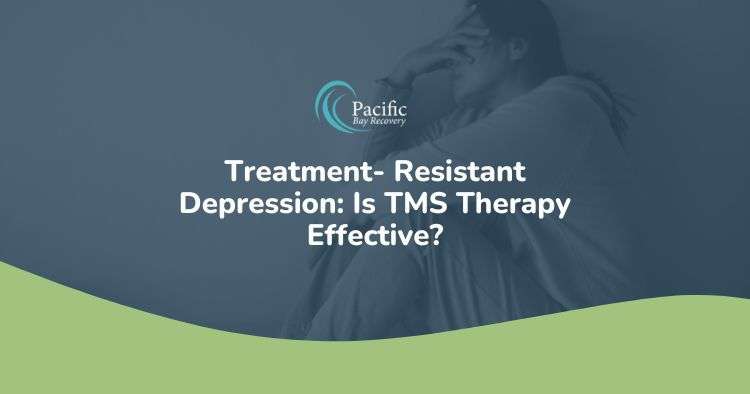How well is the treatment for your depression working? Does the treatment help a little, but you still do not feel like the darkness has lifted? Maybe you feel as if the treatment is not working, whatsoever. If the answer is yes, you might be experiencing TRD, or treatment-resistant depression also referred to as a refractory depression.
Depression treatments, unfortunately, do not always work. As many as 2/3 of people who have depression are not helped by the original antidepressant they try. And up to 1/3 do not respond to multiple treatment attempts.
However, if your treatment for depression is not working, do NOT give up. The majority of people may get their TRD under control. You and your physician simply need to figure out the proper approach. That may include various drugs, TMS therapy, and other types of treatments. If you are still experiencing depression despite treatment, here is what you should know:
What Is Treatment-Resistant Depression?
Feeling occasionally hopeless or sad is a natural and normal part of life. It happens to all people. For those who have depression, those feelings may become long-lasting and intense. It may lead to issues at school, home, or work.
Usually, depression can be treated using a combination of antidepressants and specific forms of therapy, which includes psychotherapy. For some people, antidepressant medications offer enough relief on their own.
While antidepressant medicines work well for most people, they do not improve symptoms for 10 to 15% of depression sufferers. Also, 30 to 40% see only a fraction of improvement in their depressive symptoms.
Depression that does not respond to antidepressant medication is referred to as a treatment-resistant depression.
TMS Therapy for Depression and Anxiety
TMS, or transcranial magnetic stimulation, is a kind of brain stimulation therapy.
TMS is a non-invasive procedure using electromagnetic pulses that stimulate nerve cells, which might improve symptoms of mental health or neurological disorders.
Transcranial magnetic stimulation is mostly used in the treatment of depression. It has experienced success in helping those who do not respond to psychotherapy and antidepressant medication. As a matter of fact, in 2008 the FDA (Food and Drug Administration) approved transcranial magnetic stimulation for that purpose.
There is also evidence that transcranial magnetic stimulation might help other types of disorders, such as Parkinson’s disease and anxiety.
Since the treatment uses repetitive electrical impulses, it is occasionally referred to as rTMS (repetitive transcranial magnetic stimulation). These words are commonly used interchangeably.
There are several potential benefits of transcranial magnetic stimulation therapy. Scientists are still researching the procedure; however, it might help these conditions:
Transcranial magnetic stimulation therapy for depression
TMS is most used in the treatment of MDD (major depressive disorder), occasionally simply referred to as a depression.
Usually, it is recommended for the ones who have not found any relief from psychotherapy and medication. It’s referred to as a treatment-resistant depression. Around 30% of people who have depression do not respond to those treatments.
According to a 2015 study, depression is connected with decreased activity in the prefrontal cortex. That region of the brain is involved with symptoms of depression, like appetite changes and low energy levels.
Transcranial magnetic stimulation might help by increasing activity in that area and stimulating nerve cells.
Transcranial magnetic stimulation therapy for anxiety
As transcranial magnetic stimulation treats psychological disorders such as OCD and depression, it might also help with anxiety. That is because those conditions frequently cause symptoms of anxiety.
Transcranial magnetic stimulation might also be beneficial for GAD (generalized anxiety disorder).
In anxiety, there is oftentimes an increase in nerve cell activity inside the prefrontal cortex. Transcranial magnetic stimulation might decrease the activity in that area, according to a study from 2019.
TMS – Magnetic Therapy Center
A consultation is arranged to go over what’s troubling you and whether transcranial magnetic stimulation is the right treatment for you. During that time, you and your physician will assess your treatment history, symptoms, and potential option for treatment.
If TMS is appropriate for you, treatment may be arranged to start immediately. During your first appointment, our San Diego rehabilitation center team will determine the best strength and placement of the magnetic field. Each treatment after that should last 37 minutes during which you’ll be alert and awake. The magnetic pulses will make a clicking noise and feel as if there is a tapping on the scalp but don’t cause any more than some mild discomfort. The doctor might have you consume an over-the-counter headache medicine before the treatment.
After being treated it is possible to drive home and resume all regular activities. Transcranial magnetic stimulation is a non-invasive treatment, which means it has no systematic effects and doesn’t involve surgery. Common transcranial magnetic stimulation side effects are transient and might involve a headache and/or mild discomfort or irritation at the treatment site.
To discuss TMS therapy for depression at our San Diego rehabilitation center contact Pacific Bay Recovery today at (619) 350-8220.


